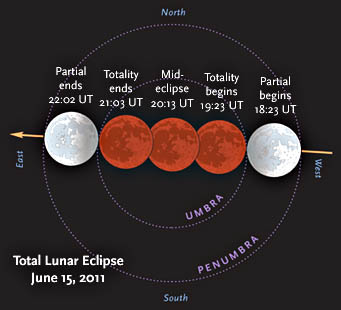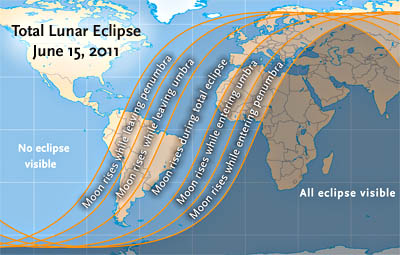We're in the midst of an interesting eclipse trifecta. Partial solar eclipses occur during the New Moons on June 1st and July 1st, which are sandwiched around a total lunar eclipse during the Full Moon on June 15th.

During June 15th's total lunar eclipse, the lunar disk will spend 100 minutes completely inside Earth's umbral shadow.
S&T: Leah Tiscione
Unfortunately, none of these are really visible from North America — which is too bad, because this lunar eclipse should be a doozy. Those of you in Europe and elsewhere in the Eastern Hemisphere are in for a real treat.
The Moon will plunge deeply into Earth's shadow, passing almost directly through its center. Consequently, totality lasts a whopping 100 minutes — the longest umbral immersion since July 2000, and nearly 40 minutes longer than the well-observed lunar eclipse last December 21st.
The lunar disk first encroaches into the penumbra, Earth's partial shadow, at 17:25 Universal Time, but don't expect to see any dusky shading along its easternmost edge for at least 30 minutes afterward. The first nibble from Earth's deep umbra comes at 18:23 UT, with the black bite taking a full hour to creep steadily across the disk.
Totality begins at 19:22:30 UT and ends at 21:02:42 UT, with the moment of greatest eclipse at 20:12:37 UT.
The long duration of this event is due in part to Earth being near aphelion in its orbit and the Moon being near perigee in its orbit. Since the lunar disk passes 5.3 arcminutes north of the umbra's center, observers might see the northern limb appear a little brighter than the southern limb.
In any case, this has the makings of a very dark eclipse. Observers rate totality's darkness using a five-point scale developed by French astronomer André Danjon, ranging from L = 0 (nearly invisible) to L = 5 (bright copper-red or orange disk). (Click here to learn more about the Danjon scale and other eclipse tips.)
David Dunham points out that the darkened lunar disk makes it very easy to watch the Moon cover up stars along its path. "Especially good will be the occultation of 4.8-magnitude 51 Ophiuchi," he notes. "Perhaps a naked-eye event, it will be spectacular as seen with binoculars or any small telescope." Click here to get a full listing of stars to be occulted during the eclipse.
And for you shutterbugs, JPL investigator Wesley Traub has a special request. He'd like to collect photometrically calibrated images of the lunar disk taken near the time of mid-eclipse, in order to measure the amount of light scattered onto the lunar disk as a function of distance from its center. "My ultimate interest is in getting data that could be useful for interpreting transit experiments on exoplanets," he explains.
(Photometrically calibrated or not, your eclipse shots would make a great addition to Sky & Telescope's online image gallery.)

The total lunar eclipse on June 15, 2011, favors observers in the Eastern Hemisphere. Click on the map for a larger version.
S&T: Leah Tiscione
As the map at right shows, the ringside seats for Wednesday's event will be centered around 50°E in longitude. This favors eastern Africa (near moonrise), Asia, and western Australia (near moonset). Those of you in Europe will see most everything, though the early stages occur before the Moon rises. Only northern Scotland and Scandinavia miss out — but, then again, they were favored for the partial solar eclipse on June 1st.
Those of us stuck in North America won't see any of this eclipse by eyeball, but we'll be able to watch it vicariously thanks to the following live webcasts:
- AstroNation.net from Hessen, Germany
- AstroViten from Oslo, Norway
- Bareket Observatory from Maccabim, Israel
- Ciclope's SkyLive.tv from Tenerife (Canary Islands)
- ECA (Eclipse Chasers Athaenium) from Delhi, India
- Eclipse-Live from Offenburg, Germany
- ServiAstro from Barcelona, Spain
- SLOOH from Tenerife (Canary Islands)
- Sky Watchers Association of North Bengal from Siliguri, India
Later this year, on December 10th, most North Americans will have a chance to see a total lunar eclipse. Let's hope for clear weather!
 5
5









Comments
Debasis Sarkar
June 12, 2011 at 12:05 am
This is to add one more link of LIVE Webcast of this TLE.
We, on behalf of Sky Watchers Association of North Bengal are going to webcast TLE of 15th June live from Siliguri, a small town of Himalayan foothills in district of Darjeeling in India. (Lat: 26.709767N// Long: 88.4357196 E).
This will be our first webcast initiative with very limited technical and financial resource. However with support from all our friends, we expect it to come out well. But this is peak Monsoon now at our location. That is a big concern. Despite being within the totality path, we missed TSE 2009 here due to cloud.
However, we welcome you all at our live webcast -
http://www.skywatchersindia.com
or
http://www.livestream.com/swansiliguri
Debasis Sarkar
You must be logged in to post a comment.
Dicky Dyson
June 13, 2011 at 9:39 am
I've been reading all sorts of astrological twoddle regarding the lunar eclipse on Wednesday. How do seemingly intelligent people believe that the Moon entering Earth's shadow can affect the stock markets etc?
It's a spectacle in itself so doesn't need any myth and lore to make it wonderful to observe. Unfortunately I'm not in a location to observe this one, but Google appear to have teamed up with some observatories to show it live on the Internet and have a free Android App to show it (eclipse.slooh.com). The observatories are in Dubai, South Africa and the Canary Islands (although I didn't think the entire eclipse is visible from the latter).
It's the 21st century; can mankind come to terms with that fact?
DD
You must be logged in to post a comment.
Alex
June 14, 2011 at 11:38 pm
Hi!
If you are interested, we are also broadcasting from Europe, Romania, from an astronomical observatory, at the following URL: http://skylovers.net
You must be logged in to post a comment.
Graham W. Wolf
June 15, 2011 at 9:36 pm
The total Lunar Eclipse was completely clouded out all night and til some 3 hrs after the Moon had set this morning (NZDT)... dastardly Southerly Front 10hrs before the big event! The Full Moon has been visually razor-sharp all week, but today at Lower Hutt (~ 10km) North of NZ's capital (Wellington) NO DICE. This is only the 3rd Lunar Eclipse out of over 40 in NZ, I've chased, where the weather has beaten me. Hopefully, overseas, other observers fared better. For some 40 yrs I've steadfastly done lunar crater and contact timings for the late great internationa co-ordinator:- Byron Soulsby of Australia. He's been dead nearly 3 years now, but his great work lives on. Hope you got a great view of the Lunar Eclipse from "upstairs", Byron!
Regards to all:- Graham W. Wolf, Lower Hutt, NZ
You must be logged in to post a comment.
Jure Atanackov
June 16, 2011 at 2:20 am
We had a great view of the eclipse from Slovenia! This was by far the darkest Lunar eclipse I've seen in my 15 years of observing. At mid eclipse I estimated the Danjon number as L=1.0 and the brightness of the eclipsed moon as +1.8. The moon was a dark copper to brown color, dark brown to grey in the center of the shadow. Lunar maria were indiscernible with the naked eye.
You must be logged in to post a comment.
You must be logged in to post a comment.